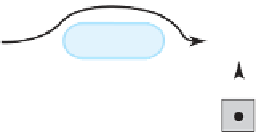Java Reference
In-Depth Information
14.6
Case 2: Removing a node other than the first one.
In the second case, we remove a node at a
position other than the beginning of the chain. Here are the steps to take:
Let
nodeBefore
reference the node before the one to be removed.
Set
nodeToRemove
to
nodeBefore
's link;
nodeToRemove
now references the node to be
removed.
Set
nodeAfter
to
nodeToRemove
's link;
nodeAfter
now references the node after the one to be
removed.
Set
nodeBefore
's link to
nodeAfter
. (
nodeToRemove
is now disconnected from the chain.)
Set
nodeToRemove
to
null
.
Since references to the disconnected node no longer exist, the system automatically recycles
its memory.
The following Java statements implement these steps, assuming that the node to remove is at posi-
tion
givenPosition
:
Node nodeBefore = getNodeAt(givenPosition - 1);
Node nodeToRemove = nodeBefore.getNextNode();
Node nodeAfter = nodeToRemove.getNextNode();
nodeBefore.setNextNode(nodeAfter);
nodeToRemove =
null
;
Figure 14-6a illustrates the chain after the first three statements execute, and Figure 14-6b
shows it after the node is removed.
FIGURE 14-6
A chain of nodes (a) just prior to removing an interior node;
(b) just after removing an interior node
(a)
nodeBefore
nodeToRemove
nodeAfter
(b)
nodeBefore
nodeToRemove
nodeAfter
The previous operations on a chain depended on the method
getNodeAt
, which returns a reference
to the node at a given position within the chain. Recall the specifications for this method:
// Returns a reference to the node at a given position.
// Precondition: The chain is not empty;
// 1 <= givenPosition <= numberOfNodes
private
Node getNodeAt(
int
givenPosition)





























